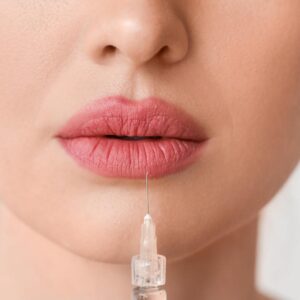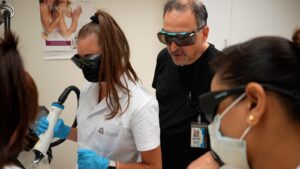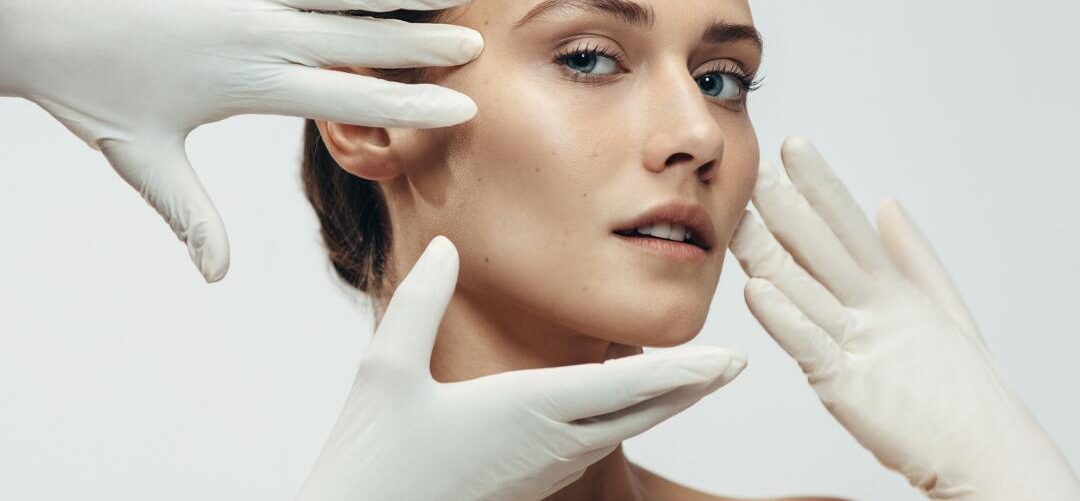The Booming Medical Aesthetic Industry: A World of Opportunity for Medical Aestheticians
 Faramarz Rafie MD / VANCODERM ACADEMY [VDA] / VANCODERM CLINIC [VDCMed]
Faramarz Rafie MD / VANCODERM ACADEMY [VDA] / VANCODERM CLINIC [VDCMed]
In the past decade, the medical aesthetic industry has evolved from a niche market into a global powerhouse. Once reserved for celebrities and the wealthy, medical aesthetics is now widely accessible and in high demand across all age groups and demographics. This explosive growth brings exciting opportunities for medical aestheticians looking to build rewarding, flexible, and future-proof careers.
How Big Is the Medical Aesthetic Industry?
The global aesthetic medicine market was valued at USD 82.46 billion in 2023 and is projected to reach approximately USD 143.3 billion by 2030, growing at a compound annual growth rate (CAGR) of 8.3% from 2024 to 2030. [Grandview Research].
One of the key drivers behind this rapid growth is the increasing societal emphasis on personal appearance, which continues to fuel demand for both surgical and non-surgical aesthetic procedures.
 Key Market Trends & Insights
Key Market Trends & Insights
- North America held the largest market share in 2023, accounting for 41.66% of global aesthetic medicine revenue.
- The market is segmented by procedure type into:
- Invasive procedures
- Non-invasive procedures
- Among these, the non-invasive segment dominated with a 38.81% market share in 2023 and is expected to experience the fastest growth rate throughout the forecast period.
This remarkable expansion is fueled by:
- A rise in non-invasive and minimally invasive procedures
- Increased demand for personalized beauty and wellness
- Advancements in laser, skin rejuvenation, and body contouring technologies
- A growing focus on self-care, anti-aging, and confidence-building
The Role of Medical Aestheticians in This Industry
 Medical aestheticians are specially trained skincare professionals who work in clinical or medical settings, often alongside dermatologists, plastic surgeons, or in medical spas. Unlike traditional estheticians, they are skilled in performing advanced procedures such as:
Medical aestheticians are specially trained skincare professionals who work in clinical or medical settings, often alongside dermatologists, plastic surgeons, or in medical spas. Unlike traditional estheticians, they are skilled in performing advanced procedures such as:
- Laser hair reduction
- Ablative and Non-Ablative Skin resurfacing
- Microneedling, Dermal Pen,
- Radiofrequency Technologies
- Ultrasound Based Platforms
- Chemical peels
- Latest generation of IPL treatments
- Advanced Skincare and Facials
- Pre- and post-operative skin care
With specialized training and certification at Designated Learning Institutitues, medical aestheticians play a critical role in helping clients achieve healthier, younger-looking skin through safe and effective procedures.
Advantages of Becoming a Medical Aesthetician
- High Demand & Job Security
- As more people seek non-surgical cosmetic enhancements, the demand for qualified medical aestheticians is soaring—especially those trained on industry-leading devices.
Lucrative Income Potential
Experienced medical aestheticians can earn competitive salaries, with additional income potential through commission, tips, and private practice opportunities.
Diverse Work Environments
You can work in medical spas, dermatology clinics, cosmetic surgery centers, wellness clinics, or even start your own aesthetic business.
Constant Innovation
The industry is full of cutting-edge technologies and techniques, offering lifelong learning and professional growth.
Empowering Work
Medical aestheticians often help clients struggling with acne, scars, hyperpigmentation, or aging—improving not only their skin but also their self-esteem and confidence.
If you’re passionate about beauty, wellness, and helping others feel their best, now is the time to explore this booming field and invest in your future as a medical aesthetician.
he growing popularity of medical aesthetic procedures reflects major shifts in cultural attitudes, technology, and consumer behavior over the past decade. Here’s a breakdown of why more people are choosing these procedures now than ever before, and how the concept of medical aesthetics has evolved:
Why People Prefer Medical Aesthetic Procedures Today’s Shift in Beauty Standards and Self-Care Culture
Modern beauty is no longer about perfection—it’s about confidence, aging well, and self-care. Aesthetic treatments are now seen as part of personal wellness, like going to the gym or eating healthy.
- People want to look refreshed, not “done.”
- There’s less stigma—”Tweakments” (subtle, non-invasive procedures) are socially accepted and often encouraged.
Technology Has Advanced Dramatically
Today’s treatments are:
- Less invasive
- More affordable
- More effective
- Require little or no downtime
From laser treatments to injectables and body contouring, medical aesthetics has become safer and more comfortable—even for first-time clients.
Rise of Social Media & Video Culture
- High-resolution cameras, filters, and video calls have made people hyper-aware of their appearance.
- Influencers and celebrities openly share their procedures, removing the taboo and creating transparency.
- The trend of “preventative aesthetics” is growing—people in their 20s and 30s are starting earlier to preserve their features rather than reverse aging later.
More Accessible Than Ever
- Aesthetic procedures are no longer exclusive to the wealthy.
- More clinics, med spas, and trained professionals are available.
- Financing options make treatments more affordable.
- Increased education and consumer awareness make people feel safer trying treatments.
Cultural Normalization & Destigmatization
What was once whispered about is now widely accepted—even celebrated. Medical aesthetics has become mainstream across age groups and genders.
- Men are now a growing segment of the market.
- Older adults seek procedures not to look young—but to look healthy and confident.
A New Era of Wellness: The Rise of Medical Aesthetics as a Right, Not a Luxury
In today’s world, the growing demand for medical aesthetic procedures reflects more than just a desire for beauty—it’s about fighting premature aging, preserving skin health, and taking control of one’s appearance and well-being.
From my perspective, this shift marks the beginning of a new era in health and wellness. People are no longer turning to aesthetic treatments purely for cosmetic enhancement—they’re doing it because they believe in their right to maintain healthy, vibrant skin, prevent early signs of aging, and feel confident in their own bodies.
This is no longer a luxury—it’s a form of preventive care.
As this industry continues to gain mainstream acceptance, I truly believe that it’s only a matter of time before insurance providers begin recognizing medical aesthetics as a valid part of health service plans. Procedures that improve quality of life, mental health, and physical well-being should be viewed as investments in long-term health, not just aesthetic indulgences.
Making Preventive Aesthetic Care Accessible to All
As the medical aesthetic industry continues to grow, one of the biggest challenges we face is ensuring that preventive skin and wellness treatments are accessible to people of all economic backgrounds, especially low-income individuals who are often left out of the conversation.
Everyone deserves the right to feel confident, healthy, and supported in their self-care journey—regardless of income. Preventive procedures like skin rejuvenation, early intervention for acne or pigmentation, and non-invasive anti-aging treatments can dramatically improve not only physical appearance but also mental health and self-esteem.
If we truly believe that medical aesthetics is part of modern wellness, we must start thinking about how to make it more inclusive.
 The Role of Education and Responsible Communication
The Role of Education and Responsible Communication
Another major issue is the spread of misinformation—particularly among young adults who are heavily influenced by social media trends, unqualified “beauty gurus,” and viral content that often promotes unsafe or ineffective treatments.
To move forward as an industry, we need to:
- Promote accurate, science-backed information
- Educate young adults on the benefits and risks of procedures
- Teach them how to make informed choices
- Encourage them to seek care from licensed professionals
- Empower them to understand that preventive care is about wellness, not perfection
This isn’t just about skin—it’s about health, trust, and empowerment.
Looking Ahead: A Call to Action
If the industry, educators, and healthcare policymakers work together, we can:
- Create community-based programs that offer affordable or subsidized treatments
- Advocate for insurance coverage of certain preventive aesthetic procedures
- Build partnerships with schools, colleges, and clinics to offer workshops and accurate resources
Ultimately, it’s not just about how we look—it’s about how we feel, how we age, and how we care for ourselves in a way that is informed, accessible, and sustainable for everyone.
 The medical aesthetic industry is experiencing rapid growth like never before, driven by increasing demand for non-invasive cosmetic procedures, technological advancements, and a growing awareness of self-care and wellness. As beauty and health continue to intersect, skilled medical aestheticians are becoming essential in clinics, spas, and wellness centers across Canada and beyond. At Vancoderm Academy, we’re proud to be at the forefront of this exciting industry, providing comprehensive, hands-on training to prepare our students for rewarding careers in medical aesthetics. Thank you for taking the time to read our blog and stay informed about this dynamic field. We’re excited to announce that our next intake for the Medical Aesthetician Diploma Program begins on October 1, 2025. Don’t miss the opportunity to join a thriving industry—apply now and start your journey with us!
The medical aesthetic industry is experiencing rapid growth like never before, driven by increasing demand for non-invasive cosmetic procedures, technological advancements, and a growing awareness of self-care and wellness. As beauty and health continue to intersect, skilled medical aestheticians are becoming essential in clinics, spas, and wellness centers across Canada and beyond. At Vancoderm Academy, we’re proud to be at the forefront of this exciting industry, providing comprehensive, hands-on training to prepare our students for rewarding careers in medical aesthetics. Thank you for taking the time to read our blog and stay informed about this dynamic field. We’re excited to announce that our next intake for the Medical Aesthetician Diploma Program begins on October 1, 2025. Don’t miss the opportunity to join a thriving industry—apply now and start your journey with us!
Have an amazing week ahead!
📚 References:
- IMARC Group — Medical Aesthetics Market Size, Share, Trends and Forecast by Product, Application, End User, and Region, 2025‑2033. Reports that the global medical aesthetics market was USD 18.3 billion in 2024, expected to reach USD 37.2 billion by 2033, growing at a CAGR of ~8.2%.
- Fortune Business Insights — Medical Aesthetics Market Growth, Share, Industry Trends, 2032. States market size ~$22.84B (2023), projected to rise to ~$67.89B by 2032, a CAGR of around 13%.
- Precedence Research — Non‑Invasive Aesthetic Treatment Market Size to Hit USD 41.55 Billion by 2034. Discusses growth of non‑invasive treatments (injectables, lasers, etc.), values for 2024, forecast to 2034.
- SkyQuest — Global Medical Aesthetics Market Size, Share & Growth Analysis, By Product / Procedure / End‑User / Region (2024‑2031). Reports USD 13.1 billion in 2022, growing to ~USD 35.6 billion by 2031.
- Grand View Research — Aesthetic Medicine Market Size, Share & Trends Analysis Report (2024‑2030). Global market valued at USD 82.46B in 2023, projected to reach USD 143.3B by 2030.
- Clara Derma — “What Are the Benefits of Being a Medical Aesthetician?” Article that describes roles, specializations, salary ranges, opportunities in Canada, differentiators vs traditional aestheticians.

